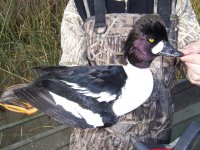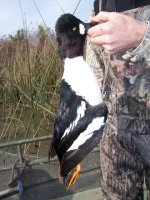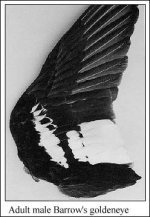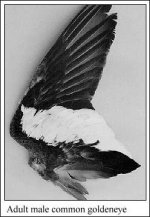You are using an out of date browser. It may not display this or other websites correctly.
You should upgrade or use an alternative browser.
You should upgrade or use an alternative browser.
Hybrid Goldeneye...
- Thread starter M. Paul Gery
- Start date
M. Paul Gery
Active member
Don't you know that when you get a duck like that, you mount it in the field first!?!?
bwahahaha!!
my buddy shot it... and yes, it's going to be mounted.
Neat looking duck. Are you going to mount it yourself?
Tim
TimJ
Well-known member
Don't you know that when you get a duck like that, you mount it in the field first!?!?
It is a drake....I should have known you'd say that.
Tim
JeffCassat
Active member
quick question.. why is this a hybrid?
JeffCassat
Active member
just by looking at it, i would assume it's just a barrows with a green head. but i should say.. i have never seen either in person, nor do i know what i'm talking about  ... just going by pics i've seen. i'm assuming they are pretty common hybrids? am i wrong in thinking that a barrow's can have a green head at some point in its life?
... just going by pics i've seen. i'm assuming they are pretty common hybrids? am i wrong in thinking that a barrow's can have a green head at some point in its life?
consider this example. like i said.. i'm just trying to learn.. not trying to say anyone is wrong.
http://www.birdinfo.com/A_Images_B/BarrowsGoldeneye2005-04-01-001.jpg
consider this example. like i said.. i'm just trying to learn.. not trying to say anyone is wrong.
http://www.birdinfo.com/A_Images_B/BarrowsGoldeneye2005-04-01-001.jpg
Last edited:
Steve Sutton
Well-known member
and not pigment and as such the angle of the light can cause "green highlights" like you see in the photo that you posted....the base color of a Barrow's is pigment and is purple.
When I look at the bird shown I see the "green" of a common which is pigment and is there no matter the angle. Turn that head to any angle with the light and the green would still be there. The shape of the head is also intermediate between the two and the "spot" doesn't match either species.
Notice on your photo the obvious "spots" on the scapulars of the Barrows that aren't there on Paul's bird. Look at a pure Common and you'll see that the upper "line" on the bird in Paul's pictures is also different than in a common. Common's have sickle shaped white feathers that make up that line....these feather are short and rounded, definately not the "spots" of a Barrow's but also not the longer feathers of a Common.
Amount of white on the entire wing is different as well....a Common's wing is almost all white with a very narrow black line between the white of the speculum and the white of the forewing...in a Barrows the amount of white is greatly reduced on the forewing which gives a wider black line that seperates the two. The wing in the pciture isn't "extended" so this isn't viewable in the photos but given all of the other characteristics I'd bet its there...
Given that this is abut the 6th "hybrid" that I've seen over the years I'd say that they are not all that rare....
Steve
When I look at the bird shown I see the "green" of a common which is pigment and is there no matter the angle. Turn that head to any angle with the light and the green would still be there. The shape of the head is also intermediate between the two and the "spot" doesn't match either species.
Notice on your photo the obvious "spots" on the scapulars of the Barrows that aren't there on Paul's bird. Look at a pure Common and you'll see that the upper "line" on the bird in Paul's pictures is also different than in a common. Common's have sickle shaped white feathers that make up that line....these feather are short and rounded, definately not the "spots" of a Barrow's but also not the longer feathers of a Common.
Amount of white on the entire wing is different as well....a Common's wing is almost all white with a very narrow black line between the white of the speculum and the white of the forewing...in a Barrows the amount of white is greatly reduced on the forewing which gives a wider black line that seperates the two. The wing in the pciture isn't "extended" so this isn't viewable in the photos but given all of the other characteristics I'd bet its there...
Given that this is abut the 6th "hybrid" that I've seen over the years I'd say that they are not all that rare....
Steve
JeffCassat
Active member
and that, my friend steve, is why i can't sit down and paint either from memory! thanks for the education. maybe one day i'll see one of those guys
jeff
jeff
TimJ
Well-known member
Steve Sutton
Well-known member
that I learned from (2) trips to Grayson's to carve was his comment....
"REFERENCE, REFERENCE, REFERENCE"....
Steve
"REFERENCE, REFERENCE, REFERENCE"....
Steve
Steve Sutton
Well-known member
the hybrids I've seen, and held, have been almost the same as a Commons.
Scapulars, head shape and "dot" are intermediate and "obvious" as soon as you see the bird in hand.
Head shape is also "intermediate" on those birds that I've seen.
Bills seem to be closer to Barrows than Commons and definately the location of the nostril, (nares), seems to be closer to a Barrows, (thats strictly "eyeball" as I've never measured the two and that cold be an illusion that doesn't prove out).
Paul's bird has more "green" in it than any of the others that I've seen.
Steve
Scapulars, head shape and "dot" are intermediate and "obvious" as soon as you see the bird in hand.
Head shape is also "intermediate" on those birds that I've seen.
Bills seem to be closer to Barrows than Commons and definately the location of the nostril, (nares), seems to be closer to a Barrows, (thats strictly "eyeball" as I've never measured the two and that cold be an illusion that doesn't prove out).
Paul's bird has more "green" in it than any of the others that I've seen.
Steve
Last edited:






